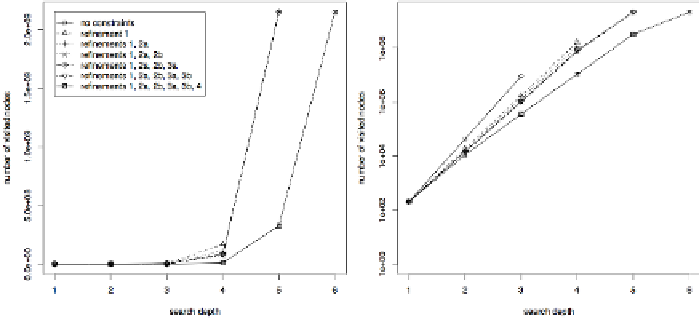Information Technology Reference
In-Depth Information
model, the more possibilities exist for their combination into workflows and
the greater is the solution space that has to be searched.
As detailed in Section 2.3.1, the synthesis universe is too large to be gener-
ated explicitly, and hence the required nodes are expanded on the fly during
the search for solutions. The overall execution time of the synthesis is in fact
clearly dominated by the execution time of the search, which corresponds
directly to the number of expanded nodes. Thus, the evaluation of the ap-
plications shows that the synthesis performance has to be improved in order
to allow for truly seamless and smooth workflow design: several minutes can
already be needed for synthesizing sequences consisting only of a handful of
services. To give an impression: running on the machine that has been used
for carrying out the experiments for the evaluation, the algorithm is able to
expand about 250,000 nodes per second. There, the search for solutions for
the (comparatively small) synthesis problems discussed for the EMBOSS sce-
nario in Section 3.3, for instance, runs for up to 3 minutes when considering
solutions until a length of 4, and already up to 257 minutes (i.e. about 4.5
hours) when searching until a depth of 5. Note that although the EMBOSS
domain model with its about 430 services is the largest among the presented
examples, is still far from future real-world domain models that would have
to cover, for instance, whole service repositories like the BioCatalogue [112],
which at the time of this writing comprises almost 2300 services.
Fig. 7.5
Synthesis statistics (number of visited nodes) for the EMBOSS scenario
Figure 7.5 illustrates the number of visited nodes and thus the runtime
performance of the synthesis in the EMBOSS scenario in greater detail. Ob-
viously, constraints can reduce the size of the search space as they decrease
the number of solutions, and thus speed up the search for solutions: For in-
stance, using only the first constraint leads to 168,239,054 visited nodes in
depth 4, while 10,847,627 nodes are visited when applying all constraints,




Search WWH ::

Custom Search